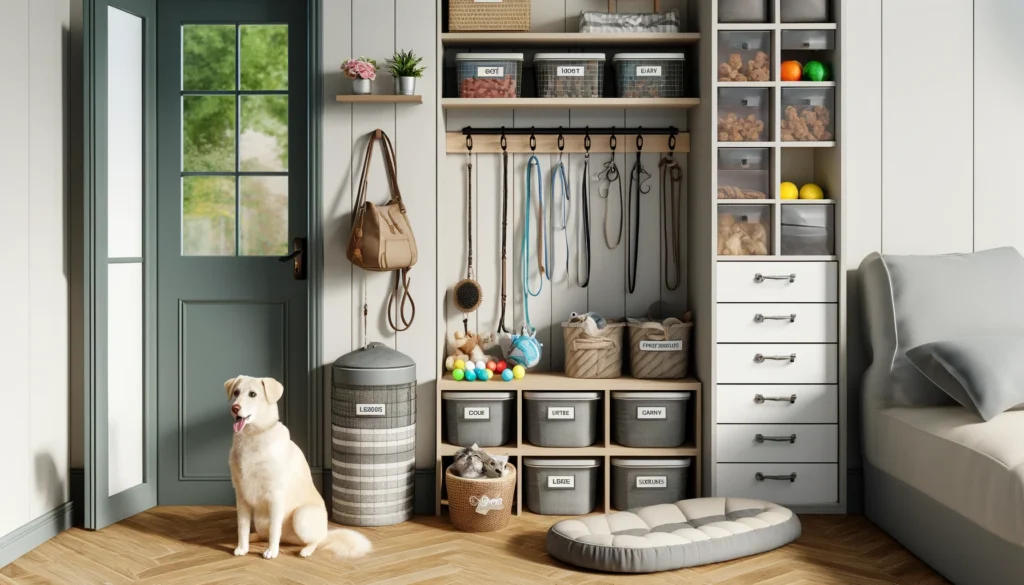If your home is starting to look like a pet store exploded — toys under the couch, leashes by the door, treats in random drawers — you’re not alone. While we love to spoil our furry companions, staying organized is key to keeping your space clean, safe, and stress-free for everyone.
Here’s a practical guide to organizing your dog or cat’s toys and accessories, while making everything easy to access and even easier to maintain.
Why Pet Organization Matters
It’s more than just aesthetics. A tidy pet area helps you:
- Save time during routines like walks or grooming
- Prevent lost or duplicated items
- Reduce stress and confusion for both pet and owner
- Improve cleanliness and hygiene
- Create a more peaceful home environment
Start With a Declutter Session
Before organizing, take inventory of what you have.
- Toss broken or unsafe toys: Check for loose parts or excessive wear.
- Donate unused accessories: Gently used items your pet ignores may be perfect for a local shelter.
- Group similar items: Leashes, brushes, toys, bowls, and treats — sort them into categories.
This process helps you see what you really need and clears out the clutter.
Create a Dedicated Pet Zone
Choose one area of your home as the go-to pet station.
- Entryway: Ideal for leashes, harnesses, and poop bags.
- Living room corner: Perfect for storing toys in baskets or bins.
- Laundry or mudroom: Great for feeding supplies and grooming tools.
Make it accessible for you, and safe for your pet.
Use Bins and Baskets to Store Toys
Loose toys can quickly overwhelm your space. Contain the chaos with containers:
- Open baskets: Great for frequently used toys your pet can access independently.
- Lidded bins: For seasonal or specialty toys you rotate.
- Label bins: Especially helpful in multi-pet households.
Choose baskets that match your decor and are easy to clean — like fabric, wicker, or plastic.
Organize by Toy Type or Use
Separating toys by purpose can help you find the right one quickly.
- Chew toys
- Fetch or tug toys
- Puzzle toys and treat dispensers
- Catnip or crinkle toys (for cats)
This is especially useful for training sessions or enriching playtime.
Create a Grab-and-Go Walk Station
Walking your dog? Make it effortless with a compact setup:
- Wall hooks: Hang leashes, collars, harnesses
- Small caddy: Store poop bags, flashlights, and portable bowls
- Treat jar: Keep it nearby for training or walk rewards
Mount everything near the door to save time during quick outings.
Set Up a Grooming and Health Supplies Drawer
Keep brushes, nail clippers, pet wipes, and medications in one organized place.
- Use a drawer divider: Prevents items from mixing
- Label each section: Helps avoid confusion (especially if multiple people care for your pet)
- Keep it out of reach: Especially important for medications and sharp tools
Consider a lockable box or drawer if your pet is curious or persistent.
Store Food and Treats Safely
Pet food can attract pests and lose freshness if not stored correctly.
- Use airtight containers: Keeps food fresh and safe from moisture
- Keep labels: Cut out feeding instructions or expiration dates and tape them to the container
- Organize treats in jars: Choose clear jars for quick visibility
Store dry food off the floor if possible, and keep treats away from strong-smelling household items.
Keep Bedding and Blankets Together
Rotating clean bedding helps reduce odors and improve hygiene.
- Use a shelf or labeled bin: Store extra blankets, pet beds, and covers
- Rotate weekly: Wash and swap to maintain freshness
- Vacuum regularly: Store near a vacuum if shedding is heavy
Always keep a backup bed or mat ready — especially useful after baths or rainy walks.
Establish a Rotation System for Toys
Rotating toys keeps your pet mentally engaged and prevents boredom.
- Choose 3–5 toys per week
- Store the rest out of sight
- Reintroduce favorites after a break to make them feel new again
This also helps you monitor toy condition and discard broken items regularly.
Final Thoughts: A Tidy Space for a Happy Pet
An organized pet area isn’t just for you — it helps your dog or cat feel more at ease. Knowing where to find their favorite toy, bed, or bowl can reduce anxiety and support their daily routine.
With a few storage solutions, a bit of planning, and regular upkeep, you’ll transform clutter into calm — and your home will be better for both you and your furry friend.






